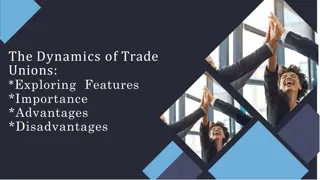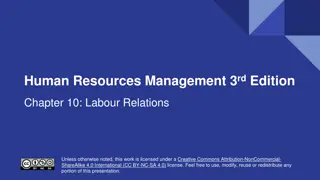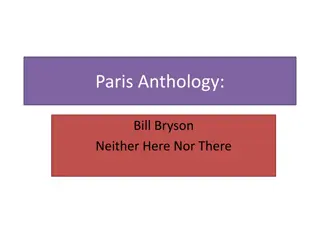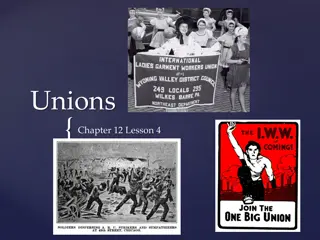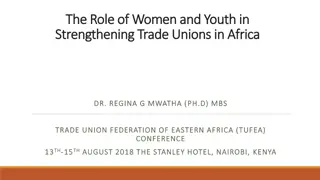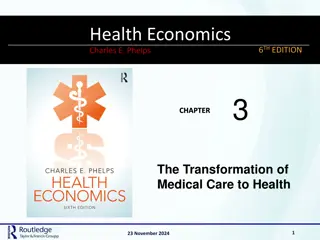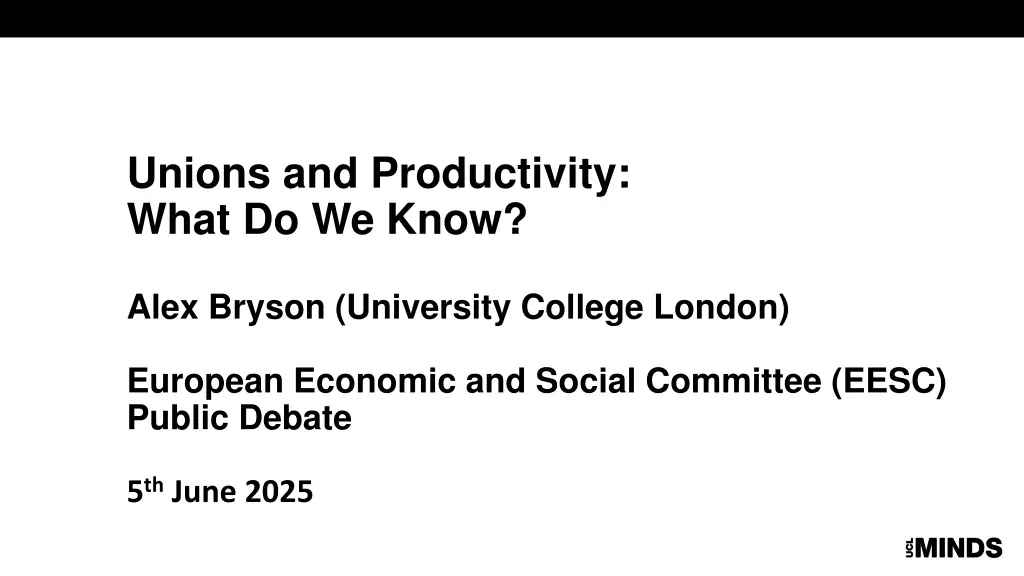
Unions and Productivity: Insights from Research and Evidence
Explore the impact of unions on productivity as discussed by Alex Bryson at a European Economic and Social Committee debate. Discover how unions can both positively and negatively influence productivity, with implications for policy and the importance of social partner interactions. Insights cover various aspects such as bargaining for higher wages, worker representation, and promoting innovation at work.
Download Presentation

Please find below an Image/Link to download the presentation.
The content on the website is provided AS IS for your information and personal use only. It may not be sold, licensed, or shared on other websites without obtaining consent from the author. If you encounter any issues during the download, it is possible that the publisher has removed the file from their server.
You are allowed to download the files provided on this website for personal or commercial use, subject to the condition that they are used lawfully. All files are the property of their respective owners.
The content on the website is provided AS IS for your information and personal use only. It may not be sold, licensed, or shared on other websites without obtaining consent from the author.
E N D
Presentation Transcript
Unions and Productivity: What Do We Know? Alex Bryson (University College London) European Economic and Social Committee (EESC) Public Debate 5thJune 2025
Overview How might unions affect productivity? What does evidence tell us? What are the implications for policy? I am going to show unions can impact productivity in many ways (good and bad) recent evidence in Europe suggests unions can have a beneficial causal impact on productivity but their impact is likely to vary a great deal across time and space the interactions between Social Partners will be key.
Bargain to raise wages above market rate (monopoly face) Increase productivity Attracts good workers (efficiency wage) Increases capital intensity (by raising relative cost of labour) Incentive to innovate Increase value added from more expensive labour Reduces labour input (lowers employment growth) Especially if bargain over wages not employment Incentive to deploy labour more efficiently Cutting edge management practices Reduce productivity Conflict: climate of employment relations; industrial action Reduces capital investment (insufficient funds; anticipate lower returns) Hold up problem: reduces rate of innovation (especially process innovation) Wage compression: reduces incentives; results in quits from high paid workers
Representation of Worker Voice to Employer (voice effect) Increases productivity Reduces quit rates, eg grievance resolution increasing contract length incentive to invest e.g. training Reduces transaction costs Efficient governance -> aggregate preferences Increased information to management Joint problem-solving Reduces productivity Voice-induced complaining -> job dissatisfaction Increased knowledge regarding management failings
Unions promote innovation at work In the past there was clear evidence of hold up problems. Not anymore Norway during COVID (Barth et al, 2022) Britain and Norway for product and process innovation (Bryson and Dale-Olsen, 2021) Organizational change in Britain via reduced job-related anxiety (Bryson et al 2013) Positively associated with high-performance workplace practices (Bryson et al. 2005) Contrast to old days of restrictive practices (Metcalf, 1989) Disparate results on unions and productivity and profitability (Doucougliagos et al 2020) Negative effects in early literature but more positive recently (Brown et al, 2009) But recent evidence of a positive causal impact on productivity in Norway (Barth et al, 2020) and that wage compression accelerates technological growth (Kost l and Svarstad, 2023) Unions as a beneficial constraint (Wolfgang Streek, 1997)
But remember.lots of heterogeneity Across country Nature of collective bargaining Coordinated, level e.g. Germany firm or sector; both in UK/Norway Varieties of capitalism Role unions play within and beyond the firm Across unions Strength (e.g. membership rates) Nature of union (e.g. militant versus partnership Bryson et al. 2011)
Membership and Coverage by Region Bhuller et al 2022
% Workplaces with Employee Representatives Forth et al 2017 Percentage of workplaces with employee representatives (50,100] (40,50] (30,40] (20,30] [0,20] FI SE EE LV DK LT IE UK PL NL BE DE CZ SK AT HU FR SI RO IT BG ES EL PT CY MT
Has Employer Demand for Unions Changed? Union as an agent of the employer Lowers transaction costs Long-term contracting voice instead of exit Information transmission Tacit knowledge of production processes raises efficiency Aggregate worker preferences (median voter) Bargaining to take wages out of competition Compete on other margins Legal compliance Protection against legal liabilities (health and safety, equality etc) Problems Do unions represent workers when density falls? reliability Alternative voice mechanisms => HRM Choosing to compete on wages Opportunities to lower wages e.g. globalization Reduction in union threat effect Increased sensitivity to union hold up and above-market wages?
Evidence of Employer Demand Changing? Demise of sectoral bargaining in Britain, Germany and elsewhere Poorly understood (Addison, Bryson, and Bellmann) But perhaps large firms using bargaining to raise wages, squeezing out less productive firms? Employer collectives (employer associations, trade associations etc) continue to play an important role in the labour market but often focused on other activities, e.g. collusion to reduce labour market competition (Bryson and Willman, 2022) Employers increasing investment in HRM to engender organizational commitment and elicit worker voice Patchy evidence but certainly in the UK unions used in combination with other forms of voice

